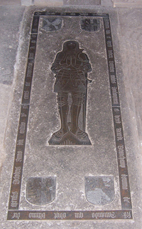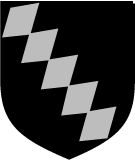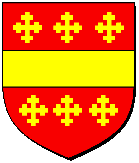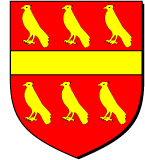
|
John Bayntun (1460-1516) in the Bayntun Chapel at the Church of St. Nicholas in Bromham (pictured above) is a full-size slab bearing a brass effigy of a man in armor. The four shields (one in each corner) represent the families of his great-great-grandparents de la Mare and de la Roche, as well as the Bayntun coat of arms in opposite corners. |
John's ancestor, Nicholas Bayntun (1382-1422) of Faulston, had married Joan, the younger daughter and co-heiress of Sir John de la Roche, and their son Sir John Bayntun (1407-c1447), afterwards married Jane, the daughter of Sir Richard Dudley – the granddaughter and eventual heiress of Elizabeth de Beauchamp, the elder daughter and co-heiress of Sir John de la Roche. Therefore the Bayntuns thus became the representatives of both families and the arms of de la Roche, de la Mare, Wanton, de Beauchamp and Beauchamp Saint Amand were blazoned as quarterings on the Bayntun shield (see above). de
BEAUCHAMP FAMILY There were two branches of the de Beauchamp family in medieval England - the de Beauchamps of Powick or Powyck and the de Beauchamps of Warwick. The family related to the Bayntuns is that of Powick on the Welsh borders. Huge de Beauchamp had this fesse (below) on his arms and they were borne by subsequent descendants of the de Beauchamp family of Elmley Castle, Worcestershire, England. When he died, he was succeeded by his son, Walter.
Walter de Beauchamp (c1073-1135) of Elmley Castle, Worcestershire, England, was Steward (dispensator) to Henry I, who appointed him Sheriff of Worcestershire and Warwickshire, and he was a special favourite with the king's daughter the Empress Maud. Walter was married to Emeline de Abitot, the daughter and heiress of Urso de Abitot. It was Robert de Abitot, the brother of Urso, that built Elmley Castle, which descended through the marriage of Emeline to the de Beauchamps and became their main residence from 1110 to 1268. Walter was succeeded, as well in his estates as in the royal stewardship, by his son, William. William de Beauchamp (c1105-1170) of Elmley Castle, Worcestershire, England, was a powerful Feudal Lord and was Sheriff of four counties – Worcestershire, Warwickshire, Gloucestershire and Hertfordshire. He was married to Maud de Braose (c1130), the daughter of William Lord de Braose, of Gower and was succeeded, at his decease, by his son, William. William de Beauchamp (1130-c1212) – Baron de Beauchamp, of Elmley Castle, Worcestershire, England, was married to Joan Walerie c1150, the daughter of Sir Thomas Walerie. He died before the 13th year of King John's reign (1211-1212) and was succeeded by his son, Walter. Walter de Beauchamp (1150-1235) of Elmley Castle, Worcestershire, England, was a Feudal Lord who was appointed Governor of Hanley Castle, Worcestershire in about 1216 and entrusted with the custody of the same shire in that turbulent year. He was married to Bertha de Braose (c1175), the daughter of William Lord de Braose, Sheriff of Hertfordshire and when he died he was succeeded by his eldest son, Walcheline. Walcheline de Beauchamp (1180-1235) – the 5th Baron of Elmley Castle, Worcestershire, England, was married to Joan Mortimer (c1212), the daughter of Lord Roger Mortimer. He died in the same year as his father and was succeeded by his only son, William. William de Beauchamp (c1215-1268), Lord of Elmley Castle, Worcestershire, England, was a noble man who attended King Henry III at Gascony in 1252 and marched under the banner of Robert de Clare, the Earl of Gloucester against the Scots in 1254. He married Isabel Mauduit, the daughter of William Mauduit of Hanslope, Buckinghamshire and the sister of William Mauduit, the Earl of Warwick. After his death, he was succeeded by his son and heir, Walter. Walter de Beauchamp (c1255-1303), of Powick, was married to Alice de Toni (c1275), a descendant of Ralph de Toni, Lord of Toni, Normandy and purchased from Reginald Fitzherbert a moiety of the manor of Alcester, Warwickshire, and made it one of his principal seats, calling it Beauchamp Court. The other manor was at Powick, Worcestershire. Walter was a very eminent person during his life and signed with the cross for a pilgrimage to the Holy Land. He had a legacy of 200 marks bequeathed to him by his father for his better performance of that voyage. He was Steward of the Household to King Edward I and attended that monarch to Flanders and into Scotland, where he shared in the honours of Falkirk on the 22nd July 1298. He was one of the Lords in the Parliament of Lincoln, being then styled "Dominus de Alcester" who signified to the Pope, under their seals, the superiority of King Edward over the Kingdom of Scotland. His third son, Giles, inherited the Lordship of Alcester by the settlement of his older brothers, who both died before him. Giles de Beauchamp (c1283-1361) – Lord of Alcester and lived at the manor house called Beauchamp Court. He had a license to fortify it in 14 Edward III (1340) to which he built a wall of stone and lime and embattled it. He was married to Catherine de Bures (c1329), the daughter of Sir John de Bures and they had two sons, the eldest, John, was his successor. John de Beauchamp (d1401), of Beauchamp Court, founded a chantry in the Parish Church of Alcester for one priest to celebrate divine service daily at the alter of All Saints and he went on an expedition against France in the 3rd year of Richard II (1379). Sir Walter was married to Elizabeth St. John and left two sons, Sir William, his successor, but when William died in 1431 he was succeeded by his brother, Sir Walter – through whom the Beauchamps became the Barons of Saint-Amand. Sir Walter de Beauchamp (1365-1430), of Beauchamp Court, married Elizabeth de la Roche (1385-1447), the eldest daughter and co-heiress of Sir John de la Roche of Bromham, Wiltshire. Sir Walter was a military person of celebrity in the reigns of Henry IV and Henry V and a Speaker in the Parliament of March 1416. This marriage had a subsequent bearing on the Bayntun family, who would eventually inherit the Manor of Bromham as representatives of both the de Beauchamp and de la Roche families. de
la ROCHE FAMILY Above the tomb of Sir Edward Bayntun (1517-1593) is the medieval stained glass of the south east window and among the armorials is Roche impaling de la Mare to represent the marriage of Sir John de la Roche to Wilhelma de la Mare.
The Bromham Roches can be traced back to Sir John de la Roche (1315-1375), of Bromham, Wiltshire, who was married, about 1333, to Agnes de Berwick, the daughter of Gilbert de Berwick of East Winterslow, Berwick in Wiltshire. He was possibly 29 years or more, when he inherited the Lordship of the Manor of Bromham Roche and was Sheriff of Wiltshire in 1333. When he died in 1375, the Manor was passed onto his 35 year old son and heir, Sir John de la Roche. Agnes was about 45 years old in 1361 when her father died and therefore born about 1316. She died about 1362, probably of the Black Death. In 1341 John was appointed by the Crown to assist the Abbot of Stanley in managing the Abbey's business affairs. He was escheator for Wiltshire in 1345 and 1347 and Sheriff of Wiltshire 1345-1346. He was appointed Justice of the Peace for his county in 1350. In 1348 John leased a messuage in Bromham to John Ballard the younger. His son was Sir John de la Roche (c1333-1400), of Bromham, and was aged just 16 at this time of his father's death and aged 30 in 1363. He was knighted in 1373. He was Ambassador to Aragon, Joint Warden of Savernake Forest, Constable of Marlborough Castle, Deputy Marshal of England, Captain of Brest, Knight of the Shire for Wiltshire and Sheriff of Wiltshire in 1381 and 1399. He was also appointed Overseer of the Royal Forests of Chippenham, Melksham and Pewsham, Keeper of Marlborough Castle and Savernake Forest and Admiral of the South and West. He was married to Wilhelma de la Mare, the daughter and heiress of Robert de la Mare of Steeple Lavington. They had two sons – Robert, who died in 1399, and William who died in the same year as his father. When Sir John died on the 30th September 1400, the Manor or Bromham Roche was passed onto his only daughter and heiress, Elizabeth. Elizabeth de la Roche (1385-1447) of Bromham, Wiltshire, received the greater part of her father’s wealth and inherited the Manor of Roches, although her sister too was sufficiently well looked after. She was married to Sir Walter de Beauchamp, of Beauchamp Court. Elizabeth died in 1447. de
la MARE FAMILY Robert de la Mare (d1212), of Lavington, held 3 fees in the Manor of Baldon in 1201, and is said to have given a virgate to Eynsham Abbey in 1198. He died in June 1212 and was succeeded by his son, Peter. Peter de la Mare (d1254), of Lavington was still a minor at the time of his father’s death for it appears that in the year 1212 the fees for the Manor of Baldon were in the custody of Warin FitzGerold, but by June 1212 Peter was in possession. He became one of the rebels who sided with the French against King John in 1216, forfeiting his Lavington property as a result, but was pardoned in 1217 and given seisin of Baldon and his the Manor of Lavington. He is heard of again in 1220 when his Heyford and Baldon manors were rated for carucate, and in 1235-6 when he paid 4 marks on his two Oxfordshire manors and was listed as Lord of the Manor of Lavington in Wiltshire. He died some time around 1254 and was succeeded by his son, Robert. Robert de la Mare (c1214-1272), The family lands passed through Robert and he held 10 hides in Baldon as one knight's fee of the Earl of Cornwall of the honor of Wallingford in 1255. He died in 1272, leaving an unmarried son, Peter, as his heir. Peter de la Mare (c1248-1292), was the holder of the Manor of Baldon in 1279 and was an important Royal Officer. He died in 1291, leaving his son and heir, Robert, a minor in the king's ward.
Robert de la Mare (c1274-1308), came of age in 1296 and obtained livery of the Manor of Baldon. In 1306 he was in the King's retinue on his Scottish expedition and in 1308 he died, leaving his child Peter as heir. As Baldon was a part of the dower lands of Lucy, Sir Robert's widow, she obtained livery of the manor on her husband's death and was subsequently entered as Lady of the Manor in the return of 1315-16. Sir Peter de la Mare (1294-1349), came of age in 1318 and in that year he obtained a grant of free warren in all his demesne lands. These included not only his two Oxfordshire manors, but property in Gloucestershire, Wiltshire, Hertfordshire, and Herefordshire. The family had estates at Steeple Lavington and elsewhere in Wiltshire; at Baldon March and Lower Heyford in Oxfordshire; at Sparsholt and Aldermaston in Berkshire; at Cherrington and Minchinhampton in Gloucestershire; at Offley in Hertfordshire and in Hertfordshire itself at Caradoc-in-Sellack and Treezveryn. Soon after, he forfeited his lands for his opposition to Edward II but they were restored in 1322, only to be again forfeited as a result of his raid with other rebels on the lands of the local magnate and Despenser protégé, John de Hadlow. He obtained a final pardon in 1324 and from then on he was engaged in the royal service and was appointed Steward in the south parts of the Duchy of Lancaster, to Henry of Grosmont (the fourth Earl and first Duke of Lancaster) a year before his death in 1349. Some years before this, he founded a chantry in the local church in 1343/4, endowing it with houses, rents, and twenty-seven acres of land with pasture for fifty sheep. He was married to Joan Achard of Aldermaston and he was succeeded by his son, Robert. Sir Robert de la Mare (c1314-1382), of Fisherton, Delamere, was married to Maud Hastings, the daughter of Hugh de Hastings. He followed his father as an important official of the Earldom and Duchy of Lancaster and from 1355 he was Steward of the lands of Henry of Grosmont, the first Duke of Lancaster, and an executor of his will. He was knighted in 1358 and in 1361 he gained the manor of Berwick St James for life. He was a Commissioner of Array in 1367, 1370 and 1375 and was a Justice of Gaol Delivery, while sitting on several other special commissions. He also sat in seven Parliaments and was Knight of the Shire in 1376. A year after his death, in July 1383, the Escheator was ordered to let Maud have the issues of the Manor of Baldon but the main family estate of Steeple Lavington was granted to his daughter, Wilhelma. Maud died on the 22nd March 1404 and her daughter, Wilhelma, inherited the title ‘Lady of Baldon’. Wilhelma de la Mare (d1410), was married to Sir John de la Roche of Bromham, Wiltshire and the Manor of Steeple Lavington thus passed out of the de la Mare family through the de la Roches. Sir John died before her in 1400 and when Wilhelma died on the 31st October 1410, the family property in Oxfordshire was divided between her daughter Elizabeth, the wife of Sir Walter de Beauchamp of Bromham and her grandson, John Bayntun. John was the four-year-old son of her second daughter, Joan, the wife of Nicholas Bayntun of Faulston. The Steeple Lavington manor again passed to Wilhelma's daughter Elizabeth (died 1447), who in turn took it in marriage to Sir Walter de Beauchamp, but when their son, Richard de Beauchamp (1453-1508), the 6th Baron Beauchamp de Saint Amand, of Bromham, died in July 1508, he left no children and his first cousin, thrice removed, Sir John Bayntun (1460-1516) was named his successor and inherited his estate. WANTON
FAMILY
BEAUCHAMP
SAINT AMAND FAMILY Alainore Saint Amand (1371-1389) – Dame de Saint Amand, of Bedford, England, was married in 1388 to Sir Gerarld de Braybrook (d1429) of Colmworth and Overton Longueville. He was Sheriff of Essex and therefore the Saint Amand line continued through to him, by right of his wife. She died on the 24th December 1389, most likely from the birth of her son, also called Gerald, and through him, once again, the Saint Amand line again continued.
Gerald de Braybrook (1389-1422) – Lord de Saint Amand of Bedford, England was born on the 24th December 1389 and was the grandson of the 4th Baron, Almaric V. When his aunt Ida died, without issue, on the 15th December 1416, he was left with full heirship, proving his age on the 17th February 1414. His first wife was Pernelle de Grey who died in 1414 and he married, secondly in 1421, Joan, the daughter of Thomas Ralegh. Upon his death in 1422, the co-heirs were his three daughters by Pernelle, his first wife – Alainore (1408-1426), Elizabeth (1409-1491) and Maude (1411-1428) and one daughter by Joan his second wife, who was also named Alainore (1422-1428). Elizabeth de Braybrook (1409-1491) – Baroness de Saint Amand, of Bromham, Wiltshire was born in 1409. She married William Beauchamp, the son of Sir Walter de Beauchamp and Elizabeth de la Roche of Powick. William became the 5th Baron de Saint-Amand by right of his wife, after the death of the last of her sisters, Maude and Alainore in 1428. Sir Walter de Beauchamp was made a Knight by Henry VI in 1433 and was one of the King's Carvers. He was Sheriff of Wiltshire in 1436, 1442 and 1447. He was appointed Chamberlain of North Wales in April 1437 and in 1442 was Keeper of Beaumaris Castle. He was Steward and Constable of Barnard Castle in 1446 and was Constable of Pains Castle in 1446. He was summoned to serve in Parliament from the 2nd January 1449 to the 26th May 1455. The summons was directed to 'Willelmo Beauchamp de Sancto Amando'. After 1449 he was addressed as 'Lord de Saint Amand' and his wife, Elizabeth, was titled 'Lady de Saint Amand'. Their son, Richard, was born in September 1453 and his father died on the 19th March 1457. Lady Elizabeth obtained a marriage license on the 10th April 1458 and was married for the second time to Roger Tocotes in July of 1458. Roger was a Knight by 1461 and by 1485 was Comptroller of the Household – an ancient position in the English Royal Household from 1489 until his death in 1492. He was Sheriff of Wiltshire three times in 1464, 1471 and and 1485 and Constable of Devizes Castle. Lady Elizabeth – Baroness de Saint Amand died on the 2nd December, 1491. She was the first soul to be buried in the Tocotes Chapel that she and her husband had just built in the Church of St. Nicholas in Bromham, Wiltshire. Roger died 11 months later on the 2nd November 1492 and was also buried in the chapel. Richard de Beauchamp (1453-1508), the 6th Baron Beauchamp de Saint Amand of Bromham, Wiltshire, England was born in September 1453. He married Lady Anne West, the daughter of Thomas West, Lord Delaware of Ardor, Wiltshire. He was convicted (attained) by the 'Act of 1484', but soon pardoned. He was made a Knight by King Henry VII about 1485, perhaps during the Coronation and he received a grant of property forfeited by his stepfather, Roger Tocotes in March of 1485. He was appointed Keeper of Blackmore Forest in Wiltshire in 1486 and in 1488 he was Commissioner of Musters in Wiltshire. In 1501 he was an officer supervising the 'Official Welcome of Catherine of Aragon' and in 1504 he served as Steward of Marlborough, Wiltshire. He left no children and died in July 1508. The title 'Lord Saint-Amand' died with Richard and his first cousin, thrice removed, Sir John Bayntun (1460-1516) was named his successor and inherited his estate. Most of these arms appeared in various locations, associated with the families, in Wiltshire such as Malmesbury which was supposed to have had the Bayntun arms displayed along with its connection to the Stumpe family. However the Victorians carried out a lot of improvements in old churches, or just pulled down many heraldic emblems and today there is no trace of these at Malmesbury. Stanley Abbey had another heraldic shield depicting the coats of arms of Bayntun, de Beauchamp, de la Roche, de la Mare and Wanton, but this Abbey is no longer standing. Lacock Abbey still has the coat of arms, including de la Roche, Hungerford and de Beauchamp – but not Bayntun. |
|
|








